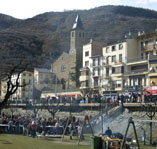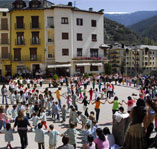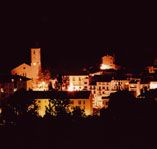


|
Sort capital of El Pallars Sobirà
The town of Sort, famous thanks to the lottery office named “La Bruixa d’Or”, does not actually mean “luck”, though at first it may seem so. Its origin is probably pre-Roman. In the Middle Ages it was called Saorte, Saort, Sabort, Sabrot and Suort.
It comes from ‘Suert’ a Basque word meaning ‘bridge’, so we are speaking about the “Valley of the village with a bridge”. Coromines, a Catalan philologist, explains that in the beginning, probably the town of Sort did not exist or it was so small that it was not really important. The Valley was ruled by the powerful monastery in Gerri, and the only thing allowed to grow next to it was on the riverbanks, the Valley of Sort with the plentiful little villages on each bank of the river La Noguera Pallaresa. Therefore, the part that mattered was the bridge, linking the two halves of the Valley, the only existing bridge on the section expanding from Gerri to Llavorsí.
Apart from being the head of the municipality, it is also the capital of El Pallars Sobirà, the one county all over Catalonia with the widest protected territory, distributed between Aigüestortes National Park –the only park with a national categorization in Catalonia- and Alt Pirineu Natural Park, the most extensive in Catalonia.
The backbone of the town is the park called ‘El Riuet’, a wide, open green area which used to be the bed of the river La Noguera Pallaresa. Running parallel to the Avenue of the Counts of Pallars, on the western side, the oldest part of the town is found, with its highlights on the Main Street, the traditional commercial route of the town and the Main Square, magnificent urban viewpoint above the avenue and the Riuet Park. Walking up the newly built streets of the old quarters, the Castle of the Counts of Pallars is reached, a panoramic view from a higher level, from where the emblematic hills of Costa Negra, at the foot of Pic de l’Orri and the Valley of Siarb can be obsereved. In this part of town, the Town Hall, and other public institutions are found, such as the Consell Comarcal del Pallars Sobirà, the County Archives, the primary and secondary schools.
On the eastern part of Sort, another urban area has developed, between El Riuet and the river La Noguera Pallaresa, which is currently employed as a white water stadium. Along the right bank of the river there is an abundance of tourist lodging, sports facilities and emergency services, composing a service area of about 1 km long where the town’s sports life is taking place, a true outdoor urban stadium, accessible to all.
On the left bank of La Noguera Pallaresa, the path called ‘Camí de Les Vernedes’ starts. It gives access to the industrial activity park, the artisan food factory, and the facilities for adventure sports enterprises. It also opens to a more extensive area called ‘Les Vernedes’, nowadays linked to another path called ‘Camí Natural de La Vall d’Assua i el Batlliu’, a leisure area for a quick stroll with the sound of the waters of La Noguera Pallaresa in the background; in 5 minutes one switches off, losing track of any urban symbol. |